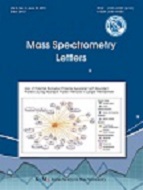
- P-ISSN 2233-4203
- E-ISSN 2093-8950

Pyrophosphates are the key intermediates in the biosynthesis of isoprenoids, and their concentrations could revealthe benefits of statins in cardiovascular diseases. Quantitative analysis of five pyrophosphates, including isopentenyl pyrophosphate(IPP), dimethylallyl pyrophosphate (DMAPP), geranyl pyrophosphate (GPP), farnesyl pyrophosphate (FPP), and geranylgeranylpyrophosphate (GGPP), was performed using liquid chromatography-tandem mass spectrometry (LC-MS/MS) in negative ionizationmode. After dilution with methanol, samples were separated on a 3 μm particle multi-modal C18 column (50 × 2 mm)and quantified within 10 min. The gradient elution consists of 10 mM ammonium bicarbonate and 0.5% triethylamine (TEA) inwater and 0.1% TEA in 80% acetonitrile was used at the flow rate of 0.4 mL/min. Overall recoveries were 51.4-106.6%, whilethe limit of quantification was 0.05 μg/mL for GPP and FPP and 0.1 μg/mL for IPP, DMAPP, and GGPP. The precision (% CV)and accuracy (% bias) of the assay were 1.9-12.3% and 89.6-111.8%, respectively, in 0.05-10 μg/mL calibration ranges (R2 > 0.993). The devised LC-MS/MS technique with the multi-modal C18 column can be used to estimate the biological activity of pyrophosphatesin plasma and may be applicable to cardiovascular events with cholesterol metabolism as well as the drug efficacy of statins.
Henneman, L. (2008). . Anal. Biochem, 383, 18-.
Henneman, L. (2011). . Biochim. Biophys. Acta, 1811, 227-.
Jauhiainen, M. (2009). . J. Chromatogr. B, 877, 2967-.
Bajad, S. U.. (2006). . J. Chromatogr. A, 1125, 76-.
Hooff, G. P. (2010). . Anal. Bioanal. Chem, 398, 1801-.
O’Neill, W. C.. (2010). . Nephrol. Dial. Transplant, 25, 187-.
Tong, H. (2008). . Anal. Biochem, 378, 138-.
Saisho, Y. (1997). . Anal. Biochem, 252, 89-.
Bicker, W. (2006). . Anal. Chem, 78, 5884-.
Stevenson, P. G. (2011). G. J. Chromatogr. A 2011. J. Chromatogr, 1218, 1822-.
Ha, Y. W. (2009). . J. Chromatogr. B, 877, 4125-.
Moon, J. Y. (2009). . J. Am. Soc. Mass Spectrom, 20, 1626-.
Pont, F. (2001). . J. Anal. Chem, 73, 3562-.